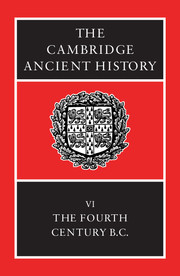Book contents
- Frontmatter
- 1 Sources and their uses
- 2 Sparta as victor
- 3 Persia
- 4 The Corinthian War
- 5 Sicily, 413–368 B.C.
- 6 The King's Peace and the Second Athenian Confederacy
- 7 Thebes in the 360s B.C.
- 8 Regional surveys I: Persian lands and neighbours
- 9 Regional surveys II: the West and North
- 10 Society and economy
- 11 The polis and the alternatives
- 12 Greek culture and science
- 12a The Growth of Schools and the Advance of Knowledge
- 12b Medicine
- 12c Greek art: Classical to Hellenistic
- 12d Greek agriculture in the classical period
- 12e Warfare
- 13 Dion and Timoleon
- 14 Macedon and north-west Greece
- 15 Macedonian hegemony created
- 16 Alexander the Great Part 1: The events of the reign
- 17 Alexander the Great Part 2: Greece and the conquered territories
- 18 Epilogue
- Chronological Table
- BIBLIOGRAPHY
- Index
- Map 1: Greece and Western Asia Minor
- Map 9: Egypt
- Map 20: Alexanders campaigns
- References
12d - Greek agriculture in the classical period
from 12 - Greek culture and science
Published online by Cambridge University Press: 28 March 2008
- Frontmatter
- 1 Sources and their uses
- 2 Sparta as victor
- 3 Persia
- 4 The Corinthian War
- 5 Sicily, 413–368 B.C.
- 6 The King's Peace and the Second Athenian Confederacy
- 7 Thebes in the 360s B.C.
- 8 Regional surveys I: Persian lands and neighbours
- 9 Regional surveys II: the West and North
- 10 Society and economy
- 11 The polis and the alternatives
- 12 Greek culture and science
- 12a The Growth of Schools and the Advance of Knowledge
- 12b Medicine
- 12c Greek art: Classical to Hellenistic
- 12d Greek agriculture in the classical period
- 12e Warfare
- 13 Dion and Timoleon
- 14 Macedon and north-west Greece
- 15 Macedonian hegemony created
- 16 Alexander the Great Part 1: The events of the reign
- 17 Alexander the Great Part 2: Greece and the conquered territories
- 18 Epilogue
- Chronological Table
- BIBLIOGRAPHY
- Index
- Map 1: Greece and Western Asia Minor
- Map 9: Egypt
- Map 20: Alexanders campaigns
- References
Summary
INTRODUCTION
Throughout Greek antiquity the ownership and cultivation of the land remained fundamental preoccupations at all levels of society, no less during the fifth and fourth centuries than at any other period. The Homeric scene of ‘two men with measures in their hands, quarrelling over boundaries in the shared ploughland’ finds its counterpart in the fourth-century lawsuit between neighbours in Attica concerning flood damage caused by one to the other's property. Instructions in the Athenian decree c. 422 for Demeter's cult at Eleusis, that ‘first-fruits of the harvest are to be offered to the Goddesses according to ancestral custom and the oracle at Delphi’ stem from the same concerns which prompted Hesiod's precept to his brother, ‘Work, so that hunger may hate you and revered Demeter may love you and fill your barn with food.’ If basic preoccupations remained unchanged, the question then arises whether or not agricultural methods and results underwent any transformation in the classical period. If they did, was this in part a response to developments in scientific thought? to increasing demand for food and growing pressure on the land? to progress made elsewhere in the ancient world? or simply to changes in climate and physical environment? If, on the other hand, they did not, was this mainly because there was no need for change, in that increased demand (generally assumed to have occurred) was satisfied by cultivating marginal land, by emigration, or by importing grain? Or, if change was needed but did not occur, was this due to the Greeks’ failure to advance technologically, or to an ingrained conservatism that preserved traditional farming practices even in the face of repeated shortfalls? Or did the proverbial poverty of Greek farmland and the harshness of the climate make further modification of technique impractical before the development of modern farm machinery and fertilizers? Had Greek agriculture already progressed as far as it could?
- Type
- Chapter
- Information
- The Cambridge Ancient History , pp. 661 - 677Publisher: Cambridge University PressPrint publication year: 1994
References
- 3
- Cited by

